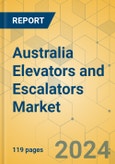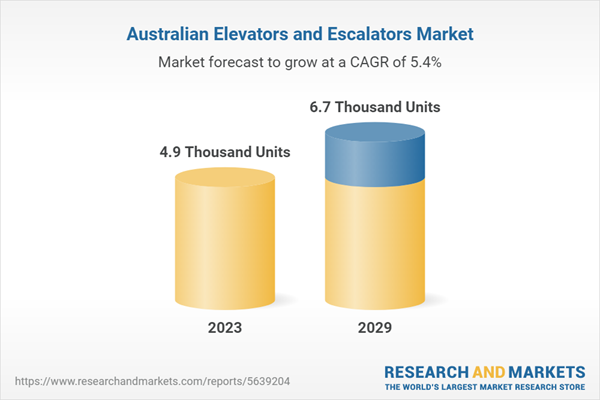Speak directly to the analyst to clarify any post sales queries you may have.
KEY HIGHLIGHTS
- Directions 2031 is a high-level spatial framework and strategic plan that establishes a vision for the future growth of the metropolitan Perth and Peel region. The Directions 2031 has also identified the need to introduce an urban expansion management program.
- The Deputy Mayor of Melbourne emphasized the need to decarbonize at least 80 commercial buildings annually to align with climate targets. The advocacy for eco-friendly building materials highlights the prominence of timber, with the Green Building Council of Australia reporting an increase in projects achieving 5-star and 6-star Green Star ratings, indicating a greater focus on sustainability.
- In 2020, the Australian government established Building 4.0 CRC as part of its cooperative research center initiative. Building 4.0 CRC will drive the construction industry into an efficient, connected, and customer-centric future through deep collaboration and emerging 4th industrial-age technology.
- The Federal Government has committed USD 5 billion to Melbourne's Airport Rail Link. The 23-kilometer link will connect Melbourne Airport in Tullamarine to the Central Business District via Sunshine. Construction is expected to begin in 2022, with the project due for completion in 2029. The growing demand for urban transportation and government efforts to expand transportation infrastructure will propel the construction and renovation of metro rails and airports across the country. These projects are further projected to support the Australia elevator and escalator market growth.
- The concentration of many people in certain parts of cities automatically leads to congested transportation networks, which is likely to cost about USD 16.5 billion each year and expected to cost more than USD 27.7Billion by 2030. '30-minute city' is one of the concepts to approach the connectivity needs of cities.
- The Australian government has established a USD 1 billion Clean Energy Innovation Fund, which will invest up to USD 100 million annually in smart, green technologies and enterprises in Australia. The National Energy Productivity Plan includes several measures to improve ecological sustainability and resilience, including the National Australian Built Environment Rating System (NABERS) and Minimum Energy Performance Standards (MEPS) for appliances, and updates accordingly to the National Construction Code.
Urbanization and Migration Remain Key Factors for Urban Development Likely to Push the Australia Elevator and Escalator Market Growth
- Dexus and Frasers Property Australia have joined forces to build a USD 2.5 billion twin-tower commercial space on a 130,000 square meter in Sydney's Tech Central, expected to be completed in 2026.
- Plans for a USD 1 billion office tower and build-to-rent apartments on Melbourne's North bank have been approved. The development site at 7 Spencer Street will include a 20-story office tower; the second tower comprises 472 apartments designed exclusively for renters.
- The permanent Migration Program is a strategy to tackle the challenges of an aging population. Migration is expected to lower the population's average age and slow the aging process, given that migrants are generally younger than the existing Australian population. Increased migration in Australia is expected to positively impact the Australian elevator and escalator market, driving demand for infrastructure development in residential and commercial spaces and fostering growth and opportunities in the industry.
The Upward Trajectory for Low Energy Buildings Initiative for Residential and Commercial Buildings to Boost Demand for Installation of Energy-Efficient Elevators
- A USD 760 million investment has been allotted to redevelop Sydney's City Tattersalls Club on Pitt Street, which includes a 50-story hotel and apartment tower. The Pitt Street project is slated to commence construction in 2022 and is expected to be completed by 2025.
- The Trajectory for Energy Buildings is a national plan to make net-zero energy commercial and residential buildings in Australia. It's a significant program aimed at achieving Australia's 40 percent increase in energy productivity by 2030, as outlined in the National Energy Productivity Plan (NEPP).
- Housing Australia has secured a significant USD 517 million lending deal in Q4 2023 to facilitate the construction of 1,370 new homes in Melbourne through collaboration with Community Housing (Vic) Limited (CHL), the Victorian Government, and industry partners. The funding, mainly sourced from a recently closed USD 422 million sustainability bond issuance, extends the total bond issuance to over USD 2.6 billion. The homes will cater to various needs, including social, affordable, market, and specialist disability accommodation, prioritizing women, children at risk of homelessness, and Indigenous Australians.
Escalators Reaching Their Average Life Expectancy Mainly in Rail Transit to Create Demand for the Maintenance of Elevators in Australia
- From 2021 to 2023, around 4,151 escalators have been recorded as having faults, including 29 stoppages per escalator, which cost USD 3.8 million for service and repair. The aging of equipment, along with heavy rain and floods, has remained a key factor that has increased the demand for the service sector in the Australia elevator and escalator market.
- The long-term growth potential of the modernization industry in Australia is driven by the digital economy approach, which integrates emerging technologies like artificial intelligence and cyber security and supports SME digitization.
Elevator Market Segmentation by:
Machine Type
- Hydraulic and Pneumatic
- Machine Room Traction
- Machine Room Less Traction
- Others
Carriage Type
- Passenger
- Freight
Capacity
- 2-15 Persons
- 16-24 Persons
- 25-33 Persons
- 34 Persons and Above
End-User
- Commercial
- Residential
- Industrial
- Others
Escalator Market Segmentation by:
Product Type
- Parallel
- Multi Parallel
- Walkway
- Crisscross
End-User
- Public Transit
- Commercial
- Others
VENDOR LANDSCAPE
- The key players in the Australia elevator and escalator market are KONE, Otis, Hyundai Elevator, TK Elevator, Mitsubishi Electric, Hitachi, and Schindler.
- The top 4 prominent vendors, including KONE, Otis, Schindler, and TKE, account for 58% of the market share in the Australia elevator and escalator market.
- Schindler is among 67 businesses in New South Wales to have obtained a silver partnership in the NSW Sustainability Advantage Program, which aims to help organizations achieve performance and improve their environmental approach.
Key Vendors
- KONE
- Mitsubishi Electric
- Schindler
- TK Elevator
- Hitachi
- Otis
Other Prominent Vendors
- Toshiba Elevator and Building Systems Corporation
- Kleemann
- Wittur
- Stannah Lifts Holdings Ltd
- LML Lift Consultants Pty Ltd
- Easy Living Home Elevators
- Innovative Lift Consulting Pty Ltd
- Direct Lifts
- Jade Elevator
- Simplex Elevators
- Nibav Lifts
KEY QUESTIONS ANSWERED
1. How big is the Australia elevator and escalator market?2. What will be the growth rate of the Australia elevator and escalator market?
3. What is the number of installed bases in the Australia elevator and escalator market in 2023?
4. What are the key opportunities in the Australia elevator and escalator market?
5. What are the key players in the Australian elevator and escalator market?
Table of Contents
Companies Mentioned
- KONE
- Mitsubishi Electric
- Schindler
- TK Elevator
- Hitachi
- Otis
- Toshiba Elevator and Building Systems Corporation
- Kleemann
- Wittur
- Stannah Lifts Holdings Ltd
- LML Lift Consultants Pty Ltd
- Easy Living Home Elevators
- Innovative Lift Consulting Pty Ltd
- Direct Lifts
- Jade Elevator
- Simplex Elevators
- Nibav Lifts
Methodology
Our research comprises a mix of primary and secondary research. The secondary research sources that are typically referred to include, but are not limited to, company websites, annual reports, financial reports, company pipeline charts, broker reports, investor presentations and SEC filings, journals and conferences, internal proprietary databases, news articles, press releases, and webcasts specific to the companies operating in any given market.
Primary research involves email interactions with the industry participants across major geographies. The participants who typically take part in such a process include, but are not limited to, CEOs, VPs, business development managers, market intelligence managers, and national sales managers. We primarily rely on internal research work and internal databases that we have populated over the years. We cross-verify our secondary research findings with the primary respondents participating in the study.

LOADING...
Table Information
| Report Attribute | Details |
|---|---|
| No. of Pages | 119 |
| Published | February 2024 |
| Forecast Period | 2023 - 2029 |
| Estimated Market Value in 2023 | 4.9 Thousand Units |
| Forecasted Market Value by 2029 | 6.7 Thousand Units |
| Compound Annual Growth Rate | 5.3% |
| Regions Covered | Australia |
| No. of Companies Mentioned | 17 |









